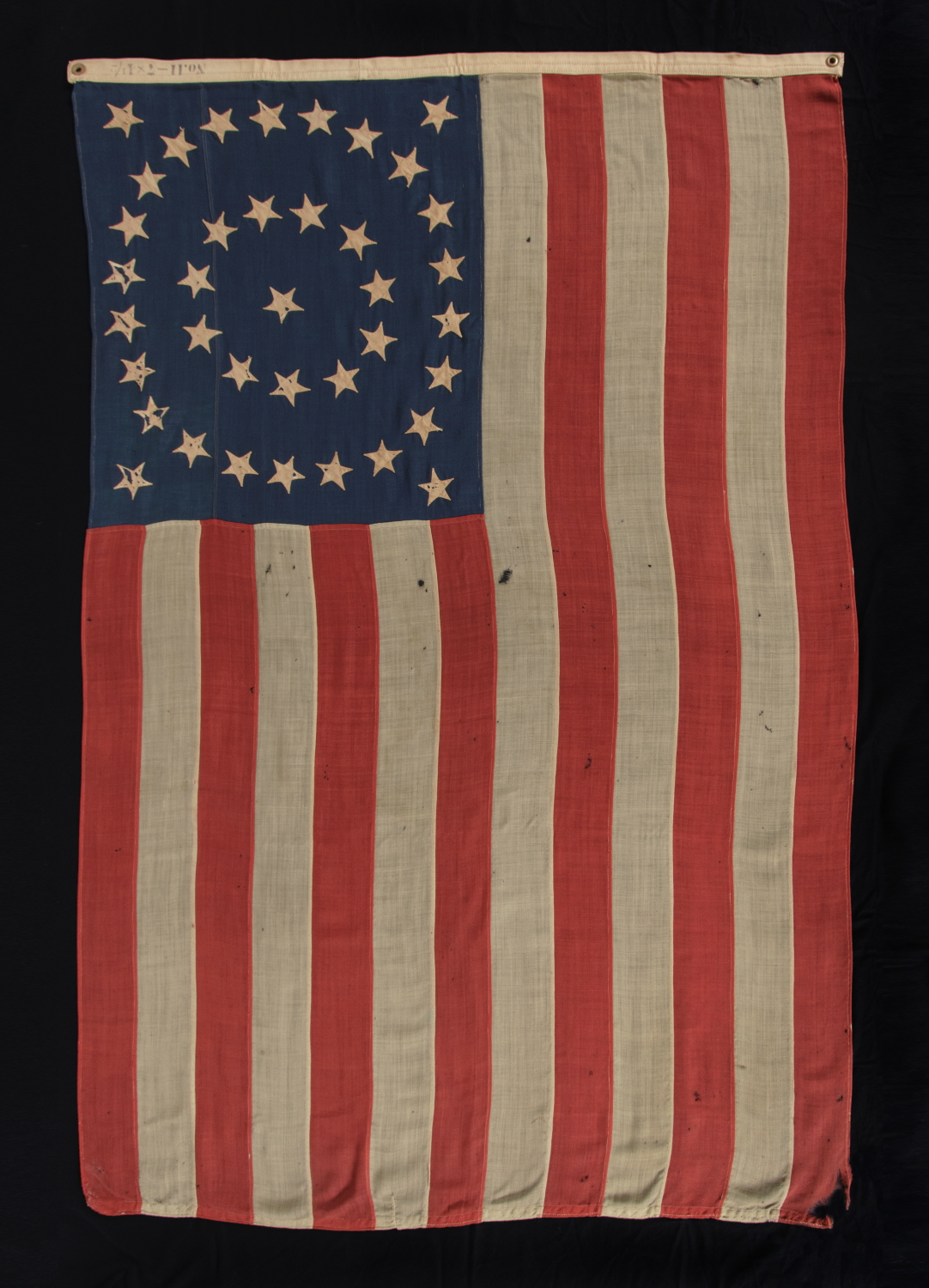
| |
38 STARS IN A MEDALLION CONFIGURATION ON A BEAUTIFUL SCALE FLAG WITH PIECED-AND-SEWN CONSTRUCTION, 1876-1889, COLORADO STATEHOOD |
|
| Available: |
Sold |
| Frame Size (H x L): |
|
| Flag Size (H x L): |
77" x 50" |
|
| Description....: |
|
38 STARS IN A MEDALLION CONFIGURATION ON A BEAUTIFUL SCALE FLAG WITH PIECED-AND-SEWN CONSTRUCTION, 1876-1889, COLORADO STATEHOOD:
38 star American national flag with a beautiful presentation of a medallion star configuration. More specifically this arrangement can be referred to as a double-wreath. Note that there are two concentric rings of stars, with a single star in the center and a flanking star in each corner of the navy blue canton. This type of pattern became popular in the antebellum period, intensified from the Civil War through the 100-year anniversary of American independence, then faded into disuse.
New stars were officially placed upon the flag on July 4th for however many states were added during the previous "flag year,", which ran from July 4th - July 3rd. Colorado entered the Union as the 38th state on August 1st, 1876. Although 37 remained the official count until July 3rd, 1877, flag-makers paid little heed to official star counts and generally added stars as soon as a new state came in, if not beforehand in hopeful anticipation of the event. Flag-making was a competitive venture and no one wanted to be making 37 star flags when others were making 38’s. It is for this reason that 38 and 13 (to reference the original 13 colonies) are the two star counts most often seen during the celebration of the 1876 centennial.
The 38 star flag was generally used until 1889, when four new states joined the Union. Decorative star patterns, however, like this one, tend to be seen on 38 star flags that were made specifically for 1876 events, such as the Centennial International Exposition in Philadelphia, a six-month long, World’s Fair event, held in conjunction with the nation’s anniversary.
Despite its appearance, the flag is unusually small for the period. In the 19th century, flags with sewn construction (as opposed to printed) were typically eight feet long or larger. This is because they were very important in their function as signals, which required that they be seen and recognized from a great distance. A small flag was six feet in length and production of flags in this length or smaller was extremely limited. Even infantry battle flags were approximately six by six-and-one-half feet, about the size of an average quilt of the same period. Because the average sewn flag of this era is difficult to frame and display in an indoor setting, many collectors prefer printed parade flags and unusually small sewn flags, like this one.
Construction: The stars of the flag are made of cotton and are double-appliquéd, meaning that they are applied to both sides). These are hand-sewn on the reverse and treadle-sewn on the obverse. The canton and stripes are made of wool bunting that has been pieced with treadle stitching. There is a heavy canvas binding along the hoist with two brass grommets. "No.11 - 7 x 4 1/2" is stenciled in black hear the top of the hoist binding on the reverse to indicate size in feet.
Condition: There is very minor mothing throughout, accompanied by minor loss from obvious use in the lower corner of the last red stripe. There is minor to moderate loss in some of the white cotton stars. There is very minor foxing and oxidation. Many of my clients prefer flags that show their age and history of use. |
|
|
|
| Collector Level: |
Advanced Collectors and the Person with Everything |
|
| Flag Type: |
Sewn flag |
|
| Star Count: |
38 |
|
| Earliest Date of Origin: |
1876 |
|
| Latest Date of Origin: |
1889 |
|
| State/Affiliation: |
Colorado |
|
| War Association: |
1866-1890 Indian Wars |
|
| Price: |
Please call (717) 676-0545 or (717) 502-1281 |
|
| |
Views: 3579 |
|
|
|

